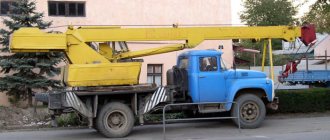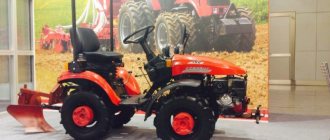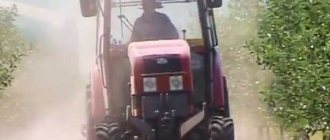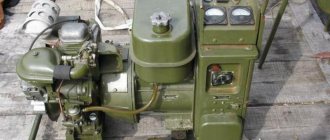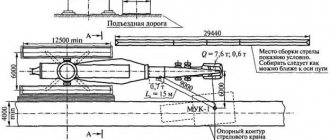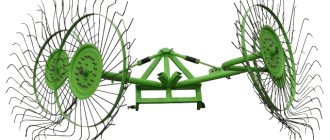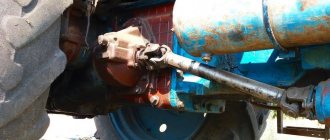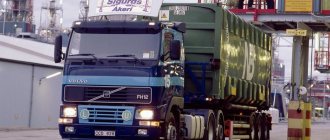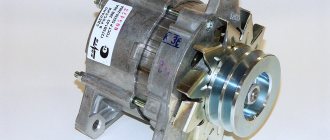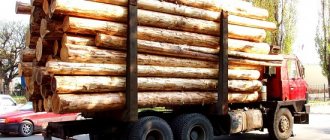A timber truck is just as necessary in the process of logging work as shafting machines. Since wood needs to be processed as quickly as possible after felling, finished stacks of logs must be transported to the processing site as soon as possible. Such a vehicle has a special cargo compartment, onto which logs are loaded and transported. In addition, the cargo body has an additional horsebox, with which you can connect several trailers to transport a large volume of timber.
A timber tractor differs from other trucks in its increased maneuverability. Such vehicles can overcome extremely difficult sections of the road. Timber trucks easily drive through loose damp soil, small rubble, and other off-road conditions.
Why are timber trucks used?
This special equipment is used in the process of logging operations in the same way as shafting machines. Due to the fact that felled wood needs to be processed as quickly as possible, it must be quickly transported to a wood processing station. This is exactly what timber trucks are used for.
Timber trucks are able to overcome off-road conditions and cope even with difficult sections of the route. The machine has a special cargo compartment where lumber is loaded. This compartment has special bunks that secure the transported logs. This way the machine can carefully and safely transport the transported assortment to its destination.
Timber trailers - design features and characteristics
Timber trailer
- one of the types of logging equipment, used for transporting harvested wood from felling sites. Coupling with the tractor is carried out using a drawbar.
Such trailers work with any tractors, both domestic and imported (Kamaz, MAZ, URAL, Scania, MAN, Volvo, etc.) Timber trailers
occupy a significant share, comparable to the share of semi-trailers and log carriers.
Advantages of Politrans timber trailers
When transporting timber from logging sites, transport conditions do not always allow the use of semi-trailers. In this case, the use of timber trailers up to 9-10 m long is justified. They are more maneuverable than semi-trailers, lighter and allow the removal of a significant volume of wood.
Loading capacity of timber trailers
reaches 40 tons, and the volume of transported assortment is 35 m3 at K = 0.8. Timber trailers "Politrans" are made in 3- and 4-axle versions.
Construction of timber trailers
Timber trailers
“Polytrans” is not very different in design from any other types of trailed equipment. It is also based on a strong, reliable frame consisting of longitudinal spars connected by transverse beams.
Platform decking
made of steel sheets (smooth or with a “lentil” pattern); if necessary, sheets of moisture-resistant plywood can serve as flooring.
Loading/unloading log trailers
carried out by side loaders. Logs are loaded in bundles that are multiples of the length of the trailer's loading platform (2.4 or 6 m). To make it easier to carry out such work, special bump stops are installed on the platform of timber trailers to prevent the forks of the loader from jamming.
The suspension is a spring-balancer bridge or a dependent leaf spring suspension.
. These types of suspensions are ideal for off-road use.
Timber bunks
Fixation of the transported load of logs is ensured by special vertical racks - bunks. They are made from high strength steel
, thereby reducing the weight of the entire semi-trailer and ensuring high reliability and safety during transportation.
The shape of the bunks is made in such a way as to withstand maximum loads
arising both during loading/unloading and during transportation of wood.
"Politrans" bunks have a composite design - if repairs or replacement are necessary, the latches are unlocked and the upper part of the bunk is removed.
Key features of Politrans timber trailers
• Reduced curb weight.
The use of high-strength steels, combined frame decking, and changes in the configuration of bunks (4 pairs) made it possible to achieve a significant reduction in weight and increase the strength of the structure.
• Versatility.
The ability to adjust the drawbar tilt (2 height positions) allows you to operate trailers with different tractors.
• Expanded basic equipment.
As standard, trailers are equipped with ABS systems, tie-down devices, light protection, tow hooks and other elements for safe and efficient operation.
What does a timber truck look like and how is it constructed?
Timber trucks have the following distinctive features:
- The base is a complex consisting of a cargo chassis and a superstructure. Most manufacturers immediately install an additional superstructure on a chassis of their own making.
- Since forestry equipment works directly in the forest and constantly moves off-road, it has high ground clearance, all-wheel drive and differential locks.
- The timber truck is equipped with longitudinal side members and lodgements (conics), which are attached directly to the vehicle frame. Experts recommend purchasing equipment that is equipped with bunks with longitudinal movement along the frame, as well as with additional fixation. That is, the more bunks, the more reliable the timber transportation will be.
- To prevent the logs from moving forward, a special grille is installed in the car in front of the cabin, which holds the logs while the car is braking.
- The vehicle is equipped with protective covers that prevent damage to the frame of the timber truck from branches, stones, ice, etc.
- Most timber trucks are equipped with hydraulic manipulators, with the help of which logs are loaded and unloaded. For this equipment, a power take-off and a pump are installed on the machine chassis.
- Such vehicles are equipped with a large fuel tank, since the operation of a timber truck requires high fuel consumption.
Deliver timber safely: review of timber trucks
Manufacturers of trailed equipment note an increase in demand for high-tech solutions for transporting timber. A wide range of new products allowing carriers to reduce transport costs was presented at an industry exhibition held in the Arkhangelsk region this summer
Mikhail Ozherelev
In Russia, for the seventh year in a row, positive dynamics in the production of unprocessed wood has been noted. According to an analysis of the forest industry conducted by Global Research Consulting, more than 129 million m3 of wood was produced in 2016, an increase in volumes of 8% compared to the previous year. Most experts agree that the positive dynamics may continue in the foreseeable future. However, the logging industry continues to experience high transportation costs. This means that the demand for highly efficient solutions for assortment transportation will only grow. Confirmation of this could be seen at a specialized exhibition held as part of the third Russian Championship among forestry equipment operators “Lumberjack of the 21st Century”, held in the Arkhangelsk region.
The SH-454 semi-trailer is equipped with bunks of its own production “MeusburgerNovtrak”
To transport timber in logs, road trains consisting of a timber hauler and a trailer or based on a truck tractor and semi-trailer are used. The semi-trailer version of the timber truck has the advantage that the tractor can be used with different semi-trailers. You can also occupy the downtime of a log semi-trailer by transporting round timber, timber, boards, and sets of finished wooden buildings. A standard tractor will fit under the timber truck, and this is another advantage of the above scheme.
Meusburger Novtruk SH-468 log semi-trailer: the use of four axles allows it to comply with axle load standards
(Veliky Novgorod) recently included the four-axle SH-468 model in its production program of semi-trailers for short-cut trucks. By the way, the idea of the appearance on the market of solutions with an added axis was suggested by life itself. It all started after the rules for transporting goods by road changed in 2015: the officially permitted gross weight of six-axle road trains was increased from 40 to 44 tons. A 4x2 truck is the most popular tractor on the market, so it was only a matter of time before it was possible to manufacture a four-axle semi-trailer for logs for it. The SH-454 model is offered on the market in three versions, differing in length and load capacity. The 13.7 m long version has the highest load capacity (46,500 kg). Its curb weight is 8,000 kg, and the load on the fifth-wheel coupling device of the tractor does not exceed 18 tons. The semi-trailer semi-trailer is built on a reinforced straight frame, for the manufacture of which Swedish OVAK O steel is used. The chassis uses 9-ton BPW axles with drum brakes. The tires are single-ply, tires with dimensions 385/65R22.5 are used. The semi-trailer suspension is pneumatic. For ease of maneuvering and increased tire mileage, the front and rear axles are liftable. The SH-454 semi-trailer is equipped with bunks of its own production “Meusburger-Novtrak” (collapsible or solid) or Finnish production with steel or aluminum racks.
The Steelbear PT-24L model features a reinforced frame and dual-pitch tires
Vologda LLC PK "Russian Truck", a well-known manufacturer of specialized road trains and timber superstructures in the North-West region, for the first time presented to the general public its new product - a three-axle semi-trailer (mod. 8993411) for transporting timber. Among the technical features of the new product with a 10-meter loading platform, mention should be made of a lightweight but durable front side (made of aluminum profile), reinforced BPW axles with dual-pitch tires, as well as patented steel bunks with a longitudinal rib - they are made of 09G2S steel and have a height of 2300 mm. According to a representative of the enterprise, such equipment allows fixing logs with a thickness of up to 400 mm and above. The curb weight of the vehicle is 37 tons, the total weight is 6500 kg. The base cost of the new model is 1.8 million rubles.
Cargo combination for driving on public roads consisting of a Volvo FH500 log truck and a Kaldary TT3128 trailer
The Steelbear brand (OJSC Velikoluksky Experimental Machine-Building Plant) presented a three-axle semi-trailer semi-trailer PT-24L with a dual-pitch tire. The total weight of the semi-trailer is 53 tons, the curb weight is 8 tons. The vehicle has a length of 13,700 mm. The frame structure is made of high-strength carbon steel Domex 700 (Sweden), operating in a temperature range from –70 to +40 °C. The reinforced chassis consists of two longitudinal I-section spars (bearing strips are made of OVAKO steel) connected by transverse beams. The semi-trailer is equipped with 12-ton BPW axles and spring suspension. The superstructure uses six pairs of steel bunks and a durable steel shield. Along the sides there is lateral aluminum underrun protection from Suer (Germany), made in accordance with UNECE Rules No. 73.00.
Timber trailer 84343A is one of the examples of products from the Novosibirsk ARP
Chelyabinsk presented a three-axle semi-trailer for timber transport TSP-941710. Its chassis uses reinforced 12-tonne BPW axles and air suspension with beam springs. The technically permissible total weight of the semi-trailer is 48 tons, the load on the fifth wheel of the tractor is 17,358 kg. The semi-trailer was demonstrated in conjunction with a MAN TGS (6x4) tractor.
Now about the version of the timber truck in the chassis-trailer configuration. This specialized solution for transporting timber is characterized by maximum load capacity, maneuverability and cross-country ability, since the trailer follows the tractor almost in tandem. Such solutions are widely used in Europe and the Scandinavian countries, and are now beginning to take root here too.
Semi-trailers for timber transportation - a new segment in the production program
And again the stand of PC “Russian Truck” LLC. Among the bestsellers, Vologda machine builders presented a three-axle log trailer (mod. 834121) with an 8-meter loading platform. The curb weight of the vehicle is 5 tons, the total weight is 30 tons. To ensure the required load capacity, the frame is reinforced with steel sheets of various thicknesses. The loading space is formed by four fixed bunks with a height of up to 2750 mm. The chassis uses 12-ton axles from the Kanash Aggregate Plant with spring suspension. On public roads they move with the flow, easily overcome inclines, and the connected front axle will help in difficult situations on a technical road.
Trailer JUKI V-31-TO-82 is well known in Russia
It is quite natural that the largest industry competition of professional skills has become a demonstration of not only domestic, but also foreign technology. The market for foreign cars in the timber segment is growing quite rapidly today. Domestic carriers buy foreign cars to minimize downtime and make service calls less often. The Scandinavian company JUKI, one of the leading suppliers of timber equipment to Russia, presented a three-axle log trailer V-31-TO-82 with spring suspension. The length of the vehicle is 8200 mm, the carrying capacity is 30 tons. The superstructure is equipped with Alukar XL3 steel bunks and a mechanical winch with straps for securing loads. According to a company representative, this model is simple and reliable and therefore is the most popular in Russia. Another confirmation was the contract signed during the exhibition with one of the largest timber processing complexes in the Arkhangelsk region.
Three-axle semi-trailer TSP-941710 with a total weight of 48 tons coupled to a MAN TGS tractor
A promising timber-carrying combination for driving on public roads was presented by the Latvian company Metsatek, a well-known manufacturer of timber-carrying superstructures from the Baltics. The vehicle consists of a log truck on a Volvo FH500 chassis with a 6x4 wheel arrangement and a Kaldary TT3128 three-axle trailer with a total weight of 28 tons. Alucar bunks and a manipulator with a Loglift 965 grab are used as superstructure elements.
As for log trucks, as well as the “Lumberjack of the 21st Century” championship itself, which, apparently, is capable of attracting a wider target audience than exhibitions at traditional venues, the Avtopark magazine is preparing a separate material on this topic.
The editors recommend:
Why do piston rings stick and how to prevent it?
A traffic police officer searched my car: did he have the right to do so?
Russians may be left without foreign cars: Western automakers have stopped supplying cars to our country
A ship that was transporting cars to Russia was detained in France
Half of the car factories in Russia have closed
News Media2
Discussion Cancel
What types of timber trucks are there?
Timber trucks are divided by type of design and type of cargo transported.
By type of construction:
- An equipped platform on which supports are installed.
- A tractor is a timber carrier equipped with special trailed equipment (semi-trailer), on which supports are placed that safely hold logs.
- The road train is the most spacious and heavy-duty timber carrier equipped with a chassis and trailer. It is used for transporting large cargo and allows you to securely secure lumber.
By type of cargo:
- A log carrier that allows you to transport any assortment, from branches to whole logs.
- Log carriers, which are used only for transporting long logs up to 6 meters in size.
Most often, log carriers with hydraulic manipulators are used. With the help of this special equipment, mechanized machines can independently load assortments onto a platform, which must be equipped with racks and cables.
Construction of timber carriers
There are two types of timber carriers - log carriers, which transport logs that have not yet been cut, and log carriers, transporting cut logs of a fixed length. Any timber carrier consists of:
- a basic truck chassis, usually all-wheel drive, with all drive wheels, capable of moving on any road and having a powerful engine;
- additional equipment that allows you to load and unload a timber truck and secure logs or logs tightly and securely during transportation.
This equipment first of all contains a subframe on which the logs are fixed and bunks - fixing devices that hold the logs while moving. The bunks are rotary and hinged, folding and lockable. In fact, bunk posts limit the position of the loaded assortment and protect it from falling out. On a timber truck, a fence is usually installed between the platform and the cabin of the vehicle, which protects the driver and passengers from the displacement of logs along the platform parallel to the axis of the vehicle.
Where to buy a timber truck?
If you want to purchase a quality product with all the documents, we recommend purchasing timber trucks from an authorized dealer. This is a legal entity that offers high-quality new special equipment and can provide guaranteed obligations.
Advantages of purchasing from an official dealer:
- Price. When purchasing from an official dealer, you do not overpay for the product. Since the dealer sells special equipment directly from the manufacturer, directly and without intermediaries. And the price of the goods already includes delivery of special equipment, storage and all government duties.
- Quality assurance. All dealer products have a warranty. And if you notice any defect or defect in the product, then you will receive a replacement without any questions. But since a defect can affect the reputation of the plant itself, the manufacturer himself simply does not provide low-quality products. After all, the more such situations a plant has, the more losses it incurs.
- Certification for each product. As soon as the plant transfers the product to the official dealer, he certifies it, thereby confirming that the product has been tested and is of high quality. To check the product, it is enough to check the certificate (official documents) for the product.
How to work on timber trucks?
To begin with, coupling belts are laid out on the base of the timber truck and trailer. After that, the assortment is carefully loaded using a hydraulic manipulator. After loading, the logs are secured with bunks and additional fastenings, and only after this the logs are transported to a warehouse or processing site. After transportation using a hydraulic manipulator, the driver unloads all the logs. You can learn more about how this happens in the video.
Video: “How to work on timber trucks?”
